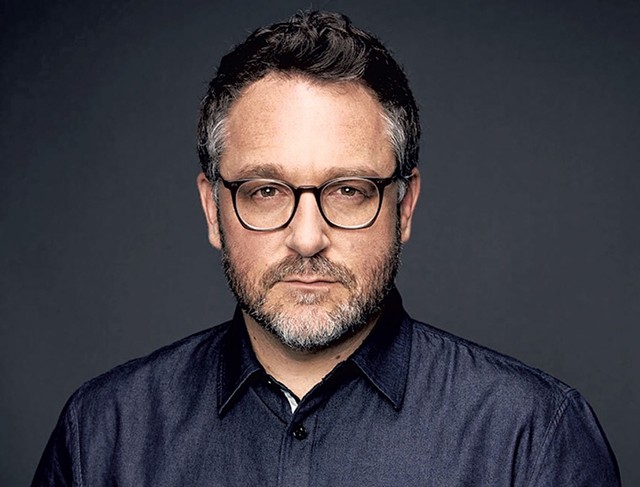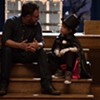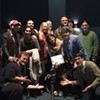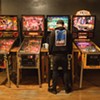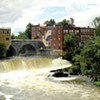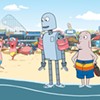Published July 15, 2015 at 10:00 a.m. | Updated December 29, 2015 at 2:09 p.m.
The blockbuster film Colin Trevorrow directed is among the most successful of all time, but he still has a sufficiently low profile that his presence at a recent screening didn't cause much of a stir. With his untucked Oxford shirt and easygoing manner, Trevorrow isn't the first guy in the room you'd peg to have directed Jurassic World, the heavyweight box-office champion of the summer (and likely beyond). He last spoke with Seven Days just before the film was released; a month later, he's had time to reflect on the cinematic tyrannosaurus that has gobbled up its competition.
Arriving at Colchester's Sunset Drive-In for a screening of his second film, Trevorrow paid his nine bucks at the ticket booth just like everybody else. Only a dozen or so patrons recognized him, and that was mostly because his young son, frolicking on the theater's playground, spilled the beans about his suddenly famous father.
In between swats at persistent mosquitoes, Trevorrow, a Burlington resident, spoke candidly about the movie that has — thanks to $1.46 billion (and counting) in global ticket sales — catapulted him into Hollywood's elite.
SEVEN DAYS: So you've never been here before?
COLIN TREVORROW: No, never been here, but I've heard a lot about it. This is my shame, having not come to the drive-in. It's pretty beautiful to have this — this is a community experience.
SD: Did you know that they still show 35mm film prints here?
CT: They're showing a print? That's incredible. I've never seen a print of my film. We made fewer than 50 prints. I love shooting on film, and I'll always shoot on film. But, as far as projection, digital's the only way to know that everybody's going to be seeing the same product. And nothing is worse than a 4-month-old film print that's barely visible.
SD: What is this now — the third-biggest-grossing film ever? Is it weird for you to see it?
CT: [Laughs] Yes, I've heard there's a lot of interest in our dinosaur film. I haven't seen it in a while. The last time was at the premiere, which was June 9 — almost a month ago. I haven't had this much distance from it and then watched it again, ever. So we'll see if I still like it. You never know.
SD: A project like Jurassic World is just so gigantic. How did you even begin to wrap your head around it?
CT: I don't know how I did it. I just did it because I had to. You know method acting? I was a method director. I completely assumed both the persona and the mind of someone who'd done it many times before. When I didn't know the answer to something, I asked a question, and I never pretended I knew something I didn't know. And I did surround myself with brilliant men and women who know how to do their jobs better than anyone in the entire world. But I also knew what I wanted at every moment, and that made it easier for them to help me achieve it.
This film is not a corporate product, even when it comes down to the product placement in the movie. That was my choice. I wanted that because that's what is real. If you built a Jurassic World [park] today, it would be owned and operated by major corporations at every turn. They'd be trying to take your money every single second, and I felt that was the way to present a reality that we all know. And I think that one of the reasons people are connecting with the movie so much is that it doesn't shy away from addressing how that corporate thirst for profit can lead us to make terrible mistakes.
SD: So you didn't set out to make the film a kind of meta-commentary? Because it lends itself to that reading.
CT: No, that was really a very natural result of what [cowriter] Derek [Connolly] and I were thinking about when we were writing, but we didn't set out to make a meta-commentary. I think that it organically turned into that because we were in a situation where you have this giant corporation that needed a sequel to this movie, and they had a start date that was set and it was happening whether it was a good idea or not. And we felt, well, that's why you would make a dinosaur theme park! There were a lot of other goals in the film, but ultimately we wanted to make a character film about somebody who was very much committed to the corporate culture who, when faced with the decision whether to embrace that side of her or to embrace her more animalistic, naturalistic, humanistic side, she chooses that other side.
SD: This shot — the sweeping aerial overview of the park — is very nice.
CT: That took a long time to render. We built that whole set, and those are real mountains, but piecing it all together was a massive endeavor. We have a shot at the end that's more than a minute long, and we were only able to render it twice. After we rendered it the second time, we made adjustments by painting things into it, but we couldn't render it again because it took so long. It was massive. It was the biggest shot that [visual effects company Industrial Light and Magic] has ever done, the most complex render they'd ever done. It's the final tracking shot where they run in through the building and back out. Ideally it feels very seamless. It's not, you know, a whole city falling apart or a whole planet exploding. It's just a couple people and a couple dinosaurs.
SD: Does any particular element of the film make you especially proud?
CT: The movie really ended up being something very true to what I had set out to do. I grade myself based not on the overall quality of the movie but on how well I accomplished what I set out to accomplish. I feel like [my first feature], Safety Not Guaranteed, was a B+ for me as far as what I set out to do. I guess I'm just sort of a B+ filmmaker — this one was a B+ for me, too. I have very high standards for myself. Obviously, this film is very successful and should not be considered a failure on the financial level, but as far as me making the best possible movie I can ... I will always feel like I have room to grow and that I will always be learning. I learned a lot from this film.
SD: Like what?
CT: I think most of all I learned a lot about perception of the audience and the need to have the same amount of empathy in your life that you have in making yourself an audience member and thinking about the ways that things are going to be perceived. There are very intelligent people who felt there was a certain amount of sexism in the way that [Bryce Dallas Howard's] character was treated. I don't discount that. I look at that, and I go back and say, "What is it that we did?" Because I know my intention was the polar opposite of that. My intention was to make a pretty badass action hero out of a woman who is transformed out of a completely corporately owned human being.
I was watching Back to the Future this morning with my son — it's the 30th anniversary of the film. I'm watching this as an adult now, and I think, God, there's incest in this moment! And it was a little startling to me to recognize that and to think, How would that have been written about today?
I like the risks we took with this movie. I love that character and I love what she goes through and I honestly don't mind that people get to decide whether they love or hate that she runs away in heels from a dinosaur. I thought it was a pretty beautiful, elegant, iconic image, so, as a filmmaker, I just got excited by it. And who knows? Maybe I didn't think through enough how it might be perceived. But I still think it's a badass-looking thing to look at.
SD: I think my favorite scene in the film is the one in which a vibrating cellphone alerts the dinosaur to the kids nearby. I enjoyed how the tension was undercut by the humor of the goofy image of Howard on the phone's screen.
CT: I wanted [the image] to look like that sort of warm photo that was taken at Thanksgiving when she was visiting once, like seven years ago. She had a certain haircut and we wrapped her in a blanket and she had a cup of hot tea. All of that was a very specific set of directions. But I didn't really try to have those kinds of particular, iconic images. I think to attempt to out-iconographize Spielberg is a fool's errand. And yet I found, in our very natural process of looking for moments that felt indelible, we found our own set of iconography. I think specifically this thing [Trevorrow assumes Chris Pratt's outstretched-arms pose from the film]...
SD: It's taken on a life of its own.
CT: Exactly. And when something takes on a life of its own, that is an iconic image. It can't be debated. Yet we didn't shoot that saying, "Oh, my God, this thing is gonna be the thing!" It was just part of the film, and the audience generates their own idea of what speaks to them the most.
SD: What's it like to see your film right here in front of you?
CT: It's cool, man! But that's the thing. Looking at it as an audience member, I would watch the hell out of this movie. This is cool. And the thing that I love most about the movie is how no one in it treats the fact that there's dinosaurs everywhere as if it's some kind of amazing thing. It's just the world they live in. And that I found to be very different from the original. This is our standard.
SD: What's going on in your head as you watch it?
CT: This movie gives me the same feeling that I had when I was a kid, watching the movies that I loved. I don't think it's exactly like those movies. But there is some kind of alchemy that happened while we were making this film, as a product of everyone having the same dream to make the same kind of film. It was a film that had a spirit to it and soul to it that allowed us all to feel like kids again. There's a certain kind of storytelling that this movie applies. It's very point-to-point, very classical. That has to be something that people are responding to. I don't think it's just because there's a bunch of cool dinosaurs. Because we've seen movies with cool dinosaurs and they didn't do anywhere nearly as well. I feel like we created something special, and the world is agreeing with us on a very populist level.
However frustrated I may get with myself for that fraction of the audience that may not love it, I've started to accept it. That happened with my first movie, too. There was, like, 10 percent of the audience that was like, "I hate this movie." Not just "eh" but "I hate it." And maybe that's just how I'm gonna be. It's gonna be groups that are like, "That's one of the greatest movies I've seen in a while," and other people who are like, "That movie killed my parents." Hey, look at the president. He's not at 100 percent, but I think he's been terrific. Whaddya gonna do?
More By This Author
Speaking of Colin Trevorrow, Jurassic World
-

Jurassic World Director Colin Trevorrow Looks Ahead
Dec 30, 2015 -

The Good, the Bad and the Wacky Films of 2015
Dec 30, 2015 -

Burlington College Wins VTIFF Film Slam
Nov 2, 2015 -

What I'm Watching: Safety Not Guaranteed
Jun 20, 2015 -

Vermonter Colin Trevorrow Talks About Directing Jurassic World
Jun 5, 2015 - More »
Comments
Comments are closed.
From 2014-2020, Seven Days allowed readers to comment on all stories posted on our website. While we've appreciated the suggestions and insights, right now Seven Days is prioritizing our core mission — producing high-quality, responsible local journalism — over moderating online debates between readers.
To criticize, correct or praise our reporting, please send us a letter to the editor or send us a tip. We’ll check it out and report the results.
Online comments may return when we have better tech tools for managing them. Thanks for reading.


































